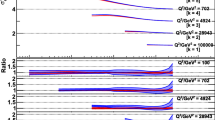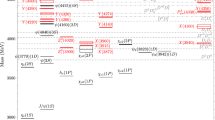Abstract
Charm, as well as Strangeness, plays an important role in searches for the Quark Gluon Plasma.J/Φ Suppression and Strangeness Enhancement are two of the earliest proposed QGP signatures. Recent theoretical work on charm in Relativistic Heavy Ion collisions has focussed on di-lepton production. However, even before the discovery of theJ/Ψ, evidence of open charm was seen in hadron collisions via the observation of promptsingle leptons “resulting from the semi-leptonic decays of charm particles.” [1] The ‘copious’ yield of direct (i.e. not from Dalitz decays) single electrons and muons—at a levele/π∼10−4 forpT≥1.3 GeV/c—observed in the early 1970’s was explained by Hinchliffe and Llewellyn-Smith and Bourquin and Gaillard as evidence of open-charm production. It is likely thate/π at RHIC is large and is a good measure of charm production. Thus, a measurement of single electrons with moderatepT>1.5 GeV/c at RHIC should give a clean charm signal in heavy ion collisions,with no combinatoric background.
Similar content being viewed by others
References
e.g. see J. A. Appel,Annu. Rev. Nucl. Part. Sci. 42 (1992) 367.
T. Matsui and H. Satz,Phys. Lett. B178 (1986) 416.
J. Rafelski and B. Mueller,Phys. Rev. Letters 48 (1982) 1066.
R. Vogt et al.,Phys. Rev. D49 (1994) 3345. See also LBL-37981, hepph/9604369.
Z. Lin and M. Gyulassy,Nuclear Gluon Shadowing via Continuum Lepton Pairs in p+A at \(\sqrt s = 200 A \cdot GeV\), nucl-th/9510041.
E. Shuryak,Can dileptons be observed in heavy ion collisions at RHIC?, nucl-th/9605011, and references therein.
A. Chilingarov et al.,Phys. Lett. 83B (1979) 136 and references therein.
Proceedings of the XVII International Conference on High Energy Physics, ed: J. R. Smith, London, July 1974, The Science Research Council, Rutherford Laboratory, UK, section V, pp. V-41–V-55.
e.g., see Leon M. Lederman,Physics Reports 26 (1976) 149, for a timely review.
I. Hinchliffe and C. H. Llewellyn-Smith,Phys. Lett. 61B (1976) 472;Nucl. Phys. B114 (1976) 45.
M. Bourquin and J.-M. Gaillard,Nucl. Phys. B114 (1976) 334.
G. Goldhaber et al.,Phys. Rev. Letters 37 (1976) 255. A good measure of the confusion on this subject is that this letter was submitted for publication more than a year before its publication in the same issue of PRL in which a second charmed meson was reported, I. Peruzzi et al., ibid.Phys. Rev. Letters 37 (1976) 569.
See reference [11] for a good discussion..
e.g., see M. R. Jane et al., Erratum,Phys. Lett.,73B (1978) 503.
F. W. Büsser et al.,Nucl. Phys. B113 (1976) 189.
G. R. Farrar and S. C. Frautschi,Phys. Rev. Letters 36 (1976) 1017. See also, C. O. Escobar,Nucl. Phys. B89 (1975) 174; and E. L. Feinberg,Nuovo Cimento 34A (1976) 391.
J. H. Cobb et al.,Phys. Lett. 78B (1978) 519.
H. Fritzsch and P. Minkowski,Phys. Lett. 69B (1977) 316.
A Lepton/Photon Spectrometer for RHIC Measurements of Lepton Pairs, Vector Mesons and Photons, RLOI-11, G. R. Young, spokesman, Brookhaven National Laboratory, July 17, 1991.
PHENIX Conceptual Design Report, S. Nagamiya, spokesman, Brookhaven National Laboratory, 29 January 1993. Also see the PHENIX web site http: //www.rhic.bnl.gov/∼phenix/physics.html
Two-Arm, Electron/Photon/Hadron Spectrometer, RLOI-2, TALES Collaboration, R. S. Hayano, spokesman, Brookhaven National Laboratory, September 27, 1990.
O. Botner et al.,Phys. Lett. B236 (1990) 488.
Direct muon experiments have similar problems from semi-leptonic decays in flight of π± andK ± mesons. e.g., see P. A. Piroue et al. in reference [8].
Asher Shor,Proceedings of the Second Workshop on Experiments and Detectors for a Relativistic Heavy Ion Collider, Berkeley, May 1987, eds: H.-G. Ritter and A. Shor, LBL-24604, p. 256–278.
Y. Akiba,PHENIX Collaboration Meeting and Theory Workshop, August 29–September 1, 1994, PHENIX Note PN-137, Brookhaven National Laboratory, Upton, NY (unpublished), 137-Vol. I, last article.
Y. Akiba,Physics with the Collider Detectors at RHIC and the LHC, Proceedings of the Pre-Conference Workshop, Quark Matter ’95, Monterey, CA, eds: Jim Thomas and Tim Hallman, UCRL-ID-121571, pp. 131–142.
Author information
Authors and Affiliations
Rights and permissions
About this article
Cite this article
Tannenbaum, M.J. Charm in PHENIX—a signal or a background?. APH N.S., Heavy Ion Physics 4, 139–148 (1996). https://doi.org/10.1007/BF03155609
Received:
Issue Date:
DOI: https://doi.org/10.1007/BF03155609




